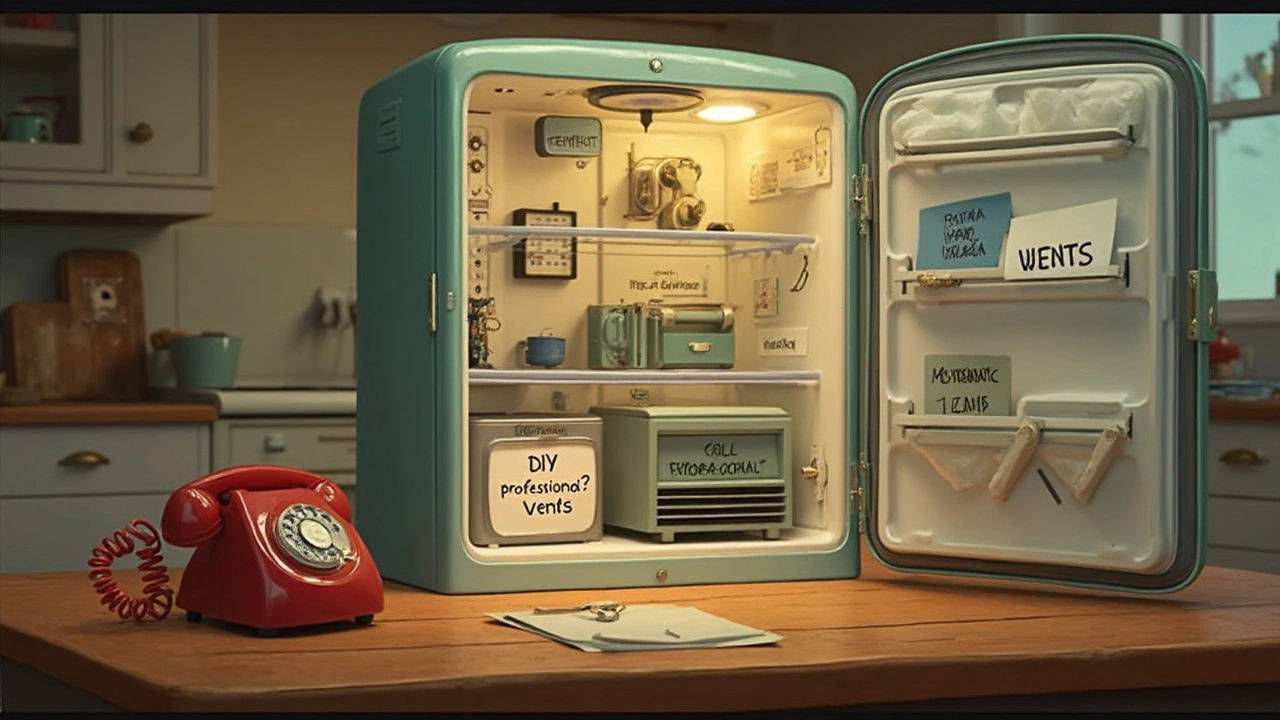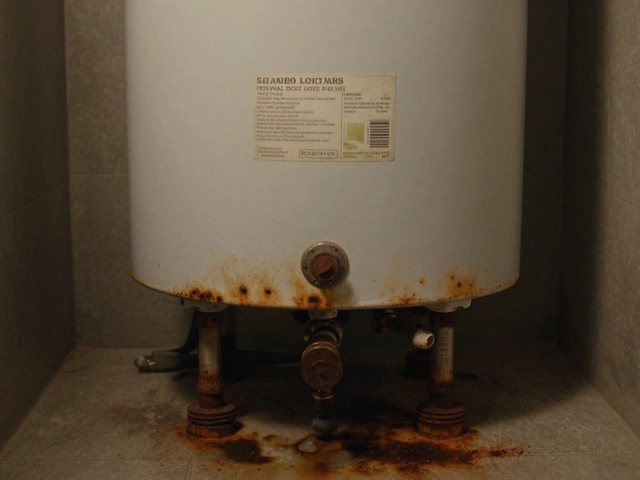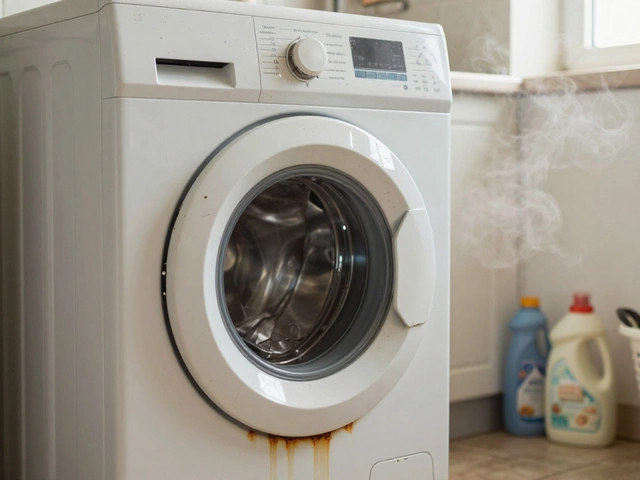Your fridge is making weird noises, food’s going bad, and suddenly, you’re wondering if you need to shop for a new one—or if there’s a way to fix it yourself without turning the kitchen into a disaster zone.
So, can you actually fix a fridge by yourself? The short answer: sometimes, but not always. Plenty of common fridge issues are a lot less complicated than they sound. Maybe it’s a blocked vent, a dirty coil, or even just a door that’s not shutting tight. If you’re handy with a screwdriver and can follow basic steps, you’ve got a real shot at tackling these fixes—even if you’ve never tried before.
But don’t just start pulling wires or yanking out parts. Knowing what you’re up against—and where your limits are—keeps you from making things worse. A basic knowledge of how your fridge works goes a long way. With the right approach, you’ll be saving time, money, and a ton of food.
- Fast Fridge Troubleshooting: What’s Actually Wrong?
- Simple Repairs You Really Can Do at Home
- DIY or Don’t Try: When to Call for Backup
- Smart Tips to Keep Your Fridge Running Longer
Fast Fridge Troubleshooting: What’s Actually Wrong?
When your fridge repair adventure starts, figuring out what's wrong is half the battle. Before you touch any tools, you need some basic detective work. Is your fridge suddenly warm? Making odd noises? Leaking puddles? Each symptom points somewhere different.
Start with the obvious checks:
- Is the fridge plugged in? No judgment. Sometimes cords get bumped loose or power strips flip.
- Is the temperature knob in the right spot? Kids, roommates, or even cleaning can mess with your settings.
- Is the door closing tight? A bad seal lets out cold air, so check for cracks or something blocking the door gasket.
If those quick checks don’t solve things, get a little more technical:
- Is the fridge light turning on when you open the door? If not, there might be a bigger power issue.
- Is the motor or compressor running? Quiet fridge? That’s actually a problem—a running motor is a good sign.
- Do you feel warmth from the back coils? No heat there can mean your fridge isn’t cycling on correctly.
- Check for frost build-up in the freezer. Too much frost means airflow problems, which can mess up cooling.
If you want a quick overview, here’s a summary of what’s most likely wrong by symptom:
| Problem | Likely Cause |
|---|---|
| Not cooling | Dirty coils, bad thermostat, compressor issues |
| Strange noises | Fan motor, compressor, items rattling inside |
| Leaking water | Clogged drain, defrost problems, tilted fridge |
| Build-up of ice | Faulty defrost heater or timer, bad door seal |
A lot of DIY refrigerator fix attempts get stumped by forgetting these basics. Don’t jump ahead to complicated repairs until you’ve ruled out the simple stuff. Grab your phone, search your specific model and problem, and see if other folks have run into the same thing in home appliance repair forums. Sometimes, the solution is hiding in plain sight.
Simple Repairs You Really Can Do at Home
Don’t let the word “repair” freak you out. Most fridge repair jobs start way simpler than people think. Here’s where you can jump in with basic tools and just a little patience.
First up is cleaning the condenser coils. If your fridge isn’t cooling right, dusty coils are usually to blame. Coils sit either behind or under your fridge. All you need is a screwdriver to open the cover and a coil brush or a vacuum. Just remember to unplug the fridge first.
- Unplug the fridge.
- Locate the coils (check behind or underneath).
- Vacuum up dust or use a coil brush (Amazon and big-box stores sell cheap ones).
- Plug it back in and see if it cools better within a couple hours.
Got water pooling at the bottom? Your drain hole may be clogged. This is super common and easy to clear up:
- Remove the bottom drawers inside the fridge.
- Find the little drain hole (usually back of the fridge, center).
- Poke it gently with a thin straw or pipe cleaner to clear gunk.
- Pour a bit of hot water to make sure it’s clear.
If your fridge is making too much noise, check if it’s sitting level. You just need to twist the front feet until it’s steady or wedge a coaster (seriously) under a corner. Odd but it works.
Cracked or brittle door seals are another quick fix. If your fridge isn’t shutting right, cold air leaks out and your food goes bad fast. Here’s what to do:
- Give the gasket a good clean with warm, soapy water and a cloth.
- If it’s loose, push it back into the groove.
- If it’s torn, replace it (new ones are easy to order online by model number).
Stats show that about 40% of DIY refrigerator fix attempts are just a loose plug or a tripped outlet. So, if your fridge isn’t running at all, double-check it’s actually plugged in and that the circuit breaker hasn’t flipped. Don’t overthink it.
| Common Issue | DIY Fix | Tools Needed |
|---|---|---|
| Fridge not cooling | Clean condenser coils | Vacuum, coil brush |
| Water pooling | Clear drain hole | Straw, hot water |
| Loud noises | Level the fridge | Screwdriver, coaster |
| Door not sealing | Clean/replace gasket | Cloth, new seal |
Don’t dive into major electrical parts or sealed systems—leave that for pros. But for everything above, you just need the right info and a steady hand.

DIY or Don’t Try: When to Call for Backup
Some fridge repair jobs are made for a weekend warrior. But certain problems are way above DIY pay grade and ignoring that can lead to a more expensive fix—or worse, a ruined fridge or a kitchen fire. Here’s how to tell when it’s time to put the screwdriver down and call someone who handles this for a living.
If your fridge is blowing warm air, tripping the breaker, or has a burned smell, don’t push your luck. Stuff like electrical shorts or leaks in the sealed coolant system is dangerous, even if it doesn’t look dramatic from the outside. If you open up the back and see oily residue or frost where it shouldn’t be, you’re probably dealing with a refrigerant leak—which needs a licensed pro by law. Coolant (often Freon or newer versions) is toxic, hard to buy, and super regulated.
- Compressor swaps: Compressors are basically the engine of your fridge. Replacing one isn’t just unplug-and-pop-in. It usually requires special tools, handling refrigerants, and technical know-how.
- Electrical components: If your issue involves the main control board, wiring harness, or other electronics, don’t risk shorting something out. You could cause a shock hazard or fry the whole unit.
- Strange sounds from inside the walls: If the noise is coming from inside the fridge panels, that could signal bad insulation or evaporator fan issues, which aren’t user-serviceable.
Wondering how often most people actually need pros? According to a 2023 home appliance service report, about 42% of DIY refrigerator fix attempts end up needing a pro anyway—usually because the root cause wasn’t clear or a part swap went sideways.
| Issue | DIY? | Call a Pro? |
|---|---|---|
| Dirty coils | ✅ | |
| Light bulb replacement | ✅ | |
| Coolant leak | ✅ | |
| Compressor replacement | ✅ | |
| Thermostat replacement | ✅ (with care) | |
| Broken door seal | ✅ | |
| Main control board | ✅ |
If the issue falls in pro territory, get a quote before you decide to repair versus replace. Sometimes, if the fridge is under ten years old, repairs are totally worth it. For really old units or anything that smells like burning, it might be time to cut your losses and start fridge shopping.
Smart Tips to Keep Your Fridge Running Longer
No one wants to shell out hundreds of bucks for a new fridge before they have to. There are a few simple habits that make a huge difference in keeping your fridge repair bills down and your food cold.
For starters, clean the condenser coils at least twice a year. You’ll find these coils either at the back or underneath, and all they need is a quick dust-off with a brush or a vacuum. According to Energy Star, dirty coils can make your fridge use almost 25% more energy, which hits your power bill hard.
“Regular cleaning and checking the door seal can significantly extend your refrigerator’s lifespan,” says the U.S. Department of Energy.
Another tip—don’t pack your fridge like you’re prepping for a hurricane. Cool air needs to move around, so keep some space between items. Also, check that the door seal isn’t loose or cracked. If you close a piece of paper in the door and it pulls out easily, those seals need replacing. Bad seals are one of the main reasons for food spoiling and higher energy bills.
Set the temperature right—between 37°F and 40°F for the fridge, and 0°F for the freezer. A cold fridge is good, but too cold just wastes energy and can actually make the compressor wear out faster. Glancing at the manual helps too, since some fridges have odd settings or features that people miss.
- Wipe up spills right away to prevent weird smells and mold.
- Defrost your freezer if it looks like the South Pole in there—ice buildup makes the motor work too hard.
- Keep your fridge at least half full. Weird, but true—the mass helps keep the temperature steady.
- Once a month, unplug and give it a 10-minute break while you clean.
If you’re curious about how these habits help, here’s what regular maintenance can mean for your fridge:
| Maintenance Task | How Often | Energy Saved |
|---|---|---|
| Clean coils | Every 6 months | Up to 25% |
| Check seals | Every 3 months | Up to 10% |
| Defrost when needed | When ice is 1/4 inch thick | 5-15% |
Doing these small jobs keeps your home appliance repair needs to a minimum and stops those emergency calls. Treat your fridge right, and you'll probably forget the last time you called for a fridge repair pro.





